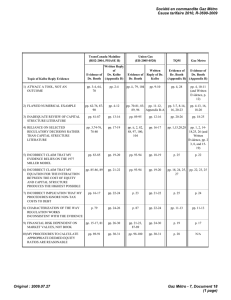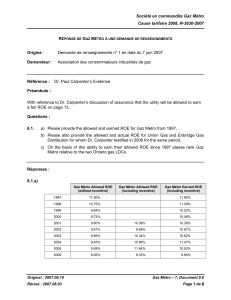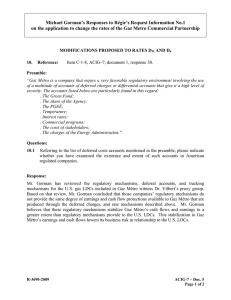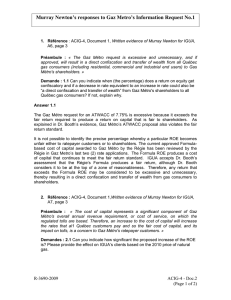Société en commandite Gaz Métro Cause tarifaire 2008, R-3630-2007 R
advertisement
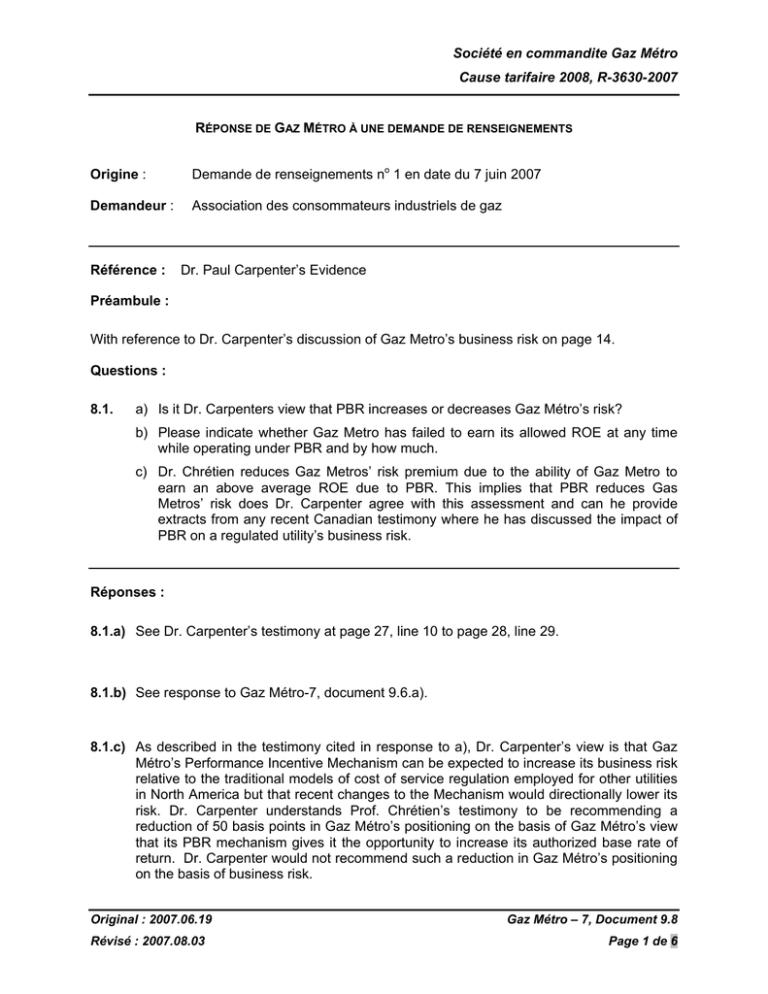
Société en commandite Gaz Métro Cause tarifaire 2008, R-3630-2007 RÉPONSE DE GAZ MÉTRO À UNE DEMANDE DE RENSEIGNEMENTS Origine : Demande de renseignements no 1 en date du 7 juin 2007 Demandeur : Association des consommateurs industriels de gaz Référence : Dr. Paul Carpenter’s Evidence Préambule : With reference to Dr. Carpenter’s discussion of Gaz Metro’s business risk on page 14. Questions : 8.1. a) Is it Dr. Carpenters view that PBR increases or decreases Gaz Métro’s risk? b) Please indicate whether Gaz Metro has failed to earn its allowed ROE at any time while operating under PBR and by how much. c) Dr. Chrétien reduces Gaz Metros’ risk premium due to the ability of Gaz Metro to earn an above average ROE due to PBR. This implies that PBR reduces Gas Metros’ risk does Dr. Carpenter agree with this assessment and can he provide extracts from any recent Canadian testimony where he has discussed the impact of PBR on a regulated utility’s business risk. Réponses : 8.1.a) See Dr. Carpenter’s testimony at page 27, line 10 to page 28, line 29. 8.1.b) See response to Gaz Métro-7, document 9.6.a). 8.1.c) As described in the testimony cited in response to a), Dr. Carpenter’s view is that Gaz Métro’s Performance Incentive Mechanism can be expected to increase its business risk relative to the traditional models of cost of service regulation employed for other utilities in North America but that recent changes to the Mechanism would directionally lower its risk. Dr. Carpenter understands Prof. Chrétien’s testimony to be recommending a reduction of 50 basis points in Gaz Métro’s positioning on the basis of Gaz Métro’s view that its PBR mechanism gives it the opportunity to increase its authorized base rate of return. Dr. Carpenter would not recommend such a reduction in Gaz Métro’s positioning on the basis of business risk. Original : 2007.06.19 Révisé : 2007.08.03 Gaz Métro – 7, Document 9.8 Page 1 de 6 Société en commandite Gaz Métro Cause tarifaire 2008, R-3630-2007 WRITTEN EVIDENCE OF PAUL R. CARPENTER FOR ENBRIDGE GAS DISTRIBUTION INC. The Brattle Group 44 Brattle Street Cambridge, Massachusetts 02138 617.864.7900 August 2006 Original : 2007.08.03 Gaz Métro - 7, Document 9.8 Page 2 de 6 Société en commandite Gaz Métro Cause tarifaire 2008, R-3630-2007 WRITTEN EVIDENCE OF PAUL R. CARPENTER 1 coordination between the needs of the electricity market and the requirements it places on 2 gas infrastructure, there is risk nonetheless. Board Staff puts it this way in its report: 3 4 5 6 7 8 9 10 11 12 A central planning function exists in the electricity market primarily through the IESO and OPA, while no provincial agency exists in the natural gas market. Board staff are not advocating a central planning function in the gas market, but information exchanges could be valuable to stakeholders. This Review is the first step in understanding the implications of new gas-fired power generators for the province’s natural gas infrastructure. However, Board staff realize that there is great uncertainty with respect to future infrastructure requirements, and periodic updates might be required.7 13 The Staff’s report points out that “many stakeholders raised concerns regarding the risks 14 associated with underutilized capacity from overbuilding and/or stranded assets.” Board 15 Staff indicated that these issues would be dealt with on a case-by-case basis.8 16 17 Q32. What do you conclude about the uncertainty of gas-fired power generation demand 18 19 for the Company’s business risk? A32. While growth in the demand for gas to supply power generation in Ontario is an 20 opportunity for the Company, it is one that creates uncertainty as to the amount, timing, 21 investment requirements, and cost recovery. Moreover, it is an opportunity for the 22 Company that may face substantial competition, as reflected in the bypass application of 23 GEC and the Board’s regulatory policy to use that competition to pick the winners. As 24 the Board Staff stated in its report cited above, there is no central planning function for 25 gas infrastructure in Ontario. This set of business risks did not exist at this level of scale 26 or uncertainty in 1993. 27 28 29 30 D. 7 8 HEIGHTENED REGULATORY UNCERTAINTY ASSOCIATED WITH THE COMPANY’S DISTRIBUTION BUSINESS Ibid., pages 27-28, emphasis added. Ibid., page 25. Original : 2007.08.03 18 Gaz Métro - 7, Document 9.8 Page 3 de 6 Société en commandite Gaz Métro Cause tarifaire 2008, R-3630-2007 WRITTEN EVIDENCE OF PAUL R. CARPENTER 1 Q33. You described changes in the Company’s market risk due to dramatic changes in 2 commodity prices. Are there any indications that this market risk may well increase 3 in the future in ways that would be of concern to investors in the Company’s equity? 4 A33. Yes. There is substantial uncertainty associated with the future regulation of the 5 Company’s gas distribution business, as recognized by the Board in its Natural Gas 6 Forum process. This uncertainty enhances the market risk that the Company faces. 7 8 Q34. What is the nature of this future uncertainty? 9 A34. As part of its Natural Gas Forum process, the Board determined that it will begin a 10 process to establish a firm gas rate regulation framework. The Board has articulated its 11 goals for a rate regulation framework as follows: 12 13 14 15 16 17 18 19 20 21 22 23 The Board believes that a multi-year incentive regulation (IR) plan can be developed that will meet its criteria for an effective ratemaking framework: sustainable gains in efficiency, appropriate quality of service and an attractive investment environment. A properly designed plan will ensure downward pressure on rates by encouraging new levels of efficiency in Ontario’s gas utilities – to the benefit of customers and shareholders. By implementing a multi-year IR framework, the Board also intends to provide the regulatory stability needed for investment in Ontario. The Board will establish the key parameters that will underpin the IR framework to ensure that its criteria are met and that all stakeholders have the same expectations of the plan.9 The Board envisions a series of generic and utility specific proceedings that together will 24 establish a firm framework for gas rate regulation. The Board described this series of 25 proceedings as follows:10 26 27 • Annual Adjustment Mechanism – “The Board will hold a generic hearing to 28 determine the appropriate base for setting the annual adjustment mechanism. The 29 Board expects that once the generic methodology is determined, its application to 30 each utility may result in different specific adjustments.” • 31 32 Rebasing – “Each IR plan must begin with a robust set of cost-based rates, based on a thorough and transparent review. The Board’s view is that a thorough cost-of-service 9 “Natural Gas Regulation in Ontario: A Renewed Policy Framework,” Report on the Ontario Energy Board Natural Gas Forum, page 22. 10 Ibid., pages 23-36. Original : 2007.08.03 19 Gaz Métro - 7, Document 9.8 Page 4 de 6 Société en commandite Gaz Métro Cause tarifaire 2008, R-3630-2007 WRITTEN EVIDENCE OF PAUL R. CARPENTER 1 rebasing must occur at the end of each IR’s plan’s term before a new plan is put in 2 place. 3 rebasing, efficiency improvements will be revealed and their benefits passed on to 4 customers through base rates for the next period. The Board will determine the base 5 rates through a hearing for each utility.” 6 • Rebasing is an important consumer protection feature. Through robust The Term of the Plan - “The Board expects that the term of IR plans will be between 7 three and five years. The Board’s view is that three years represents the minimum 8 term that may be expected to give rise to productivity increases, and its preference is 9 for a term of five years. The Board is reluctant to approve a term greater than five 10 years at this time, give the importance of ensuring that productivity gains are passed 11 on to customers in subsequent periods. The term of the plan will be determined in the 12 generic hearing on the annual adjustment mechanism.” 13 • Service Quality Monitoring – “The Board will develop the service quality framework, 14 and will undertake a consultation to finalize the measures, standards and reporting 15 mechanism. 16 framework.” 17 • The Board expects to use its rule making tools to implement this Financial Reporting – “The Board will consult with stakeholders and modify the Gas 18 Reporting and Record Keeping Requirements (RRRs) as necessary to meet the 19 requirements for financial reporting in the new ratemaking framework. While the 20 Board intends to conduct this consultation and modify the RRRs before the 21 development of the first IR plan, it expects that the RRRs may be further refined in 22 the context of specific IR plan development.” 23 • Data Filing Guidelines – “The Board will undertake a review of the gas utility data 24 filing guidelines for rate hearing processes, and then develop a set of draft filing 25 guidelines, which it will distribute for consultation. Wherever possible, the Board 26 will seek to develop consistent guidelines for Union and Enbridge, and will consider 27 issues such as electronic filings.” 28 • The Role of Alternative Dispute Resolution – “The Board is mindful of the concerns 29 stakeholders have expressed and the efforts they have made to propose improvements 30 to the ADR process. The Board will not decide at this time the precise structure of Original : 2007.08.03 20 Gaz Métro - 7, Document 9.8 Page 5 de 6 Société en commandite Gaz Métro Cause tarifaire 2008, R-3630-2007 WRITTEN EVIDENCE OF PAUL R. CARPENTER 1 the ADR process. The Board has already undertaken a review of the ADR process, 2 and it will consider the submissions made through the Natural Gas Forum before 3 releasing its conclusions in the ADR review. The Board expects that the ADR 4 process will evolve further in the process leading up to the first IR applications.” 5 6 The resolution of all of these issues by the Board will determine the extent to which the 7 future market risk faced by the Company and its shareholders will increase over and 8 above current market risk. Current uncertainty regarding the ultimate resolution of these 9 issues exposes the Company and its shareholders to an additional regulatory risk. 10 11 Q35. What do you conclude with respect to the Company’s business risk as it relates to its 12 13 equity thickness and cost of capital? A35. Since the last time the Board examined the Company’s business risk as it relates to its 14 deemed equity thickness there have been significant changes in the market in which the 15 Company operates. The Company’s business risk today is higher than it was in 1993 due 16 to fundamental changes and increased uncertainty in gas and oil commodity markets and 17 the potential for bypass of its distribution facilities. Substantial uncertainty as to the 18 effect of the Ontario Government’s new gas-fired electricity generation initiatives on 19 required natural gas infrastructure in the province may place potentially new and large 20 financing requirements on the Company with uncertain outcomes. Finally, investors in 21 the Company’s equity will also recognize that there is significant uncertainty as to the 22 regulatory model that will apply to the Company in the future, as reflected in the issues 23 before the Board in its Natural Gas Forum process. For all of these reasons I conclude 24 that an increase in the Company’s equity thickness is warranted. 25 26 Q36. Does this complete your written evidence? 27 A36. Yes, it does. Original : 2007.08.03 21 Gaz Métro - 7, Document 9.8 Page 6 de 6
